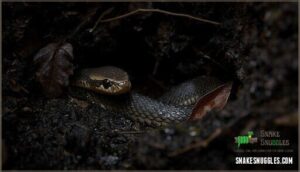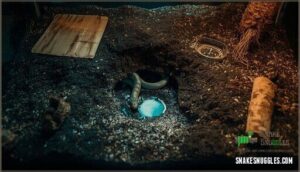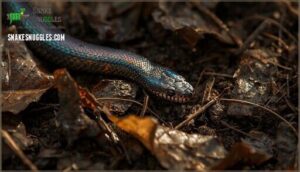This site is supported by our readers. We may earn a commission, at no cost to you, if you purchase through links.

Every feature on Xenopeltis unicolor has a purpose underground. The wedge-shaped head cuts through soil like a blade. The cylindrical body follows behind with muscular precision. Smooth scales reduce friction as the snake disappears into the earth. You’ll rarely see one above ground unless heavy rain floods its tunnels. Understanding this species means understanding what happens beneath your feet.
Table Of Contents
- Key Takeaways
- Sunbeam Snake Species Guide
- Appearance and Colors
- Burrowing Behavior
- Enclosure Setup
- Feeding
- Health Issues
- Finding and Picking a Sunbeam Snake
- Facts
- History and Evolution
- Population & Conservation Status
- Frequently Asked Questions (FAQs)
- How often should a sunbeam snake be fed?
- What should I do if my sunbeam snake stops eating?
- Are sunbeam snakes endangered?
- Are sunbeam snakes social animals?
- Can sunbeam snakes swim in water?
- How do sunbeam snakes reproduce and mate?
- Are sunbeam snakes venomous to humans?
- What predators hunt sunbeam snakes naturally?
- Do sunbeam snakes need UVB lighting?
- Conclusion
Key Takeaways
- Sunbeam snakes aren’t just pretty—their iridescent scales evolved as a friction-reducing adaptation for life underground, where their wedge-shaped heads and smooth bodies push through waterlogged soil in Southeast Asian swamps.
- Success in captivity hinges on replicating their fossorial lifestyle with 6-8 inches of moist substrate, 75-100% humidity, and minimal handling, since most wild-caught specimens die within six months due to stress.
- Despite their striking appearance, these snakes are living fossils from a primitive lineage dating back 100 million years, with only two species worldwide and virtually no successful captive breeding documented since the 1990s.
- Their conservation status remains stable (Least Concern) across Southeast Asia, but habitat loss from agricultural expansion poses the primary threat to populations that live almost entirely underground.
Sunbeam Snake Species Guide
Sunbeam snakes belong to the family Xenopeltidae, with Xenopeltis unicolor being the primary species in Southeast Asia. You’ll find these fossorial reptiles across Thailand, Malaysia, Indonesia, and the Philippines, where they inhabit lowland tropical environments below 1,000 meters. The species identification is straightforward—look for their distinctive iridescent scales that shimmer like a rainbow when light hits them. Their taxonomy origins trace back millions of years as primitive snake species.
While genetic variations exist across their range, no recognized regional subspecies have been formally classified. These snakes exhibit unique traits, including a wedge-shaped head adapted for burrowing and a white neck ring in juveniles that fades within their first year, making species information essential for proper identification and care. They thrive in environments with high humidity levels.
Appearance and Colors
These snakes showcase one of nature’s most striking optical effects. Their scales act like tiny prisms, bending light into vivid rainbow colors that shift as you move around them. This scale iridescence comes from microscopic structures in the upper scale layer that refract wavelengths between 400 and 700 nanometers.
Here’s what defines sunbeam snake appearance:
- Dorsal coloration: Dark purplish-brown to black base color creates dramatic contrast with the rainbow sheen
- Iridescent scales: Smooth, polished scales reflect red, blue, green, and violet depending on lighting effects
- Ventral surface: Light gray or white underside with no patterning
- Juvenile markings: White collar around the neck that disappears within a year
- Body profile: Wedge-shaped head and cylindrical body averaging 3 feet long
The appearance colors intensify in direct sunlight, while shaded snakes look mostly black. Visual perception varies based on angle—you’ll see more yellows and reds at oblique views. Snake coloration depends on color genetics and environmental factors like humidity. They’re also known to live in southern China.
Burrowing Behavior
When you observe their underground lifestyle, you’ll notice how every physical trait has a purpose. The wedge-shaped head pushes through soft soil like a living shovel. Their cylindrical body and powerful muscles drive them through dense, waterlogged substrates typical of swamp habitats. Smooth scales minimize friction during movement.
Every physical trait serves a purpose—the wedge-shaped head shovels through soil, powerful muscles drive through waterlogged substrates, and smooth scales minimize friction underground
Sunbeam snake behavior centers on secondary burrows—shelters originally created by other animals. These refuges maintain humidity above 75% and stable temperatures around 77°F. Fossorial snakes like these rarely surface except after heavy rainfall or during nocturnal emergence periods lasting 5–15 minutes.
Substrate preferences reveal their ecological needs clearly:
| Substrate Type | Moisture Level | Suitability |
|---|---|---|
| Waterlogged soil | >75% humidity | Best |
| Moist sandy loam | 40–75% humidity | Adequate |
| Dry sand | <40% humidity | Unsuitable |
| Compacted clay | Variable | Poor |
Burrowing adaptations like these link directly to soil interaction and prey detection. Their head functions as a chemical sensor during brief surface trips. Substrate depth in their natural range commonly reaches 4–8 inches, where they remain concealed during daylight hours. Burrow structure provides protection from predators while supporting their role in tropical soil aeration.
Enclosure Setup
Your enclosure setup determines whether your sunbeam snake thrives or struggles. Tank size matters—adults need at least 20 gallons with 20 inches of floor space, though 32-quart tubs work well in collections. Substrate depth directly impacts burrowing behavior, so provide 6–8 inches of peat-based soil mixed with sand or coconut coir.
Follow these steps for proper enclosure setup:
- Choose a secure enclosure with a locking lid to prevent escapes.
- Add substrate at least 6 inches deep for natural burrowing.
- Create a temperature gradient from 80–85°F on the warm side to 70–75°F on the cool side using an under-tank heater.
- Maintain humidity control between 75–100% through daily misting and covered mesh tops.
- Place hiding spots like cork flats or lightweight logs on the substrate surface, avoiding heavy rocks.
Keep decorations minimal. A shallow water dish completes the sunbeam snake enclosure without overwhelming their fossorial lifestyle.
Feeding
Your sunbeam snake’s diet depends on replicating what they’d hunt in the wild. In Southeast Asia, wild sunbeam snakes consume frogs, lizards, and small rodents—with amphibians and reptiles making up roughly 40–45% of their prey.
In captivity, most keepers simplify the captive diet to mice exclusively. Start hatchlings on pinky mice, then switch to fuzzy mice as they grow. Adults usually eat 2–3 hopper mice every two weeks. Prey size matters—choose food no wider than your snake’s head since their jaw structure limits gape width. Frozen mice work better than live mice, preventing injury from rodent bites.
Feed juveniles weekly and adults biweekly. Their feeding behavior peaks at night, especially after misting sessions that trigger their natural hunting instincts.
Health Issues
Why do respiratory infections and mite infestations strike so many captive sunbeam snakes? Poor enclosure conditions create the perfect storm for health issues. Infection rates can exceed 30% when humidity drops below 50%, weakening your snake’s immune system. Mite infestations affect up to 18% of captive snakes and cause anemia if left untreated.
Watch for these warning signs:
- Respiratory infections – Wheezing, nasal discharge, and open-mouth breathing signal bacterial problems requiring 10–21 days of antibiotics
- Shedding problems – Low humidity causes incomplete sheds in 80% of cases, risking skin infections and vision impairment
- Bone disease – Calcium deficiency leads to skeletal deformities, reducing bone density by 33% within four months
Stress reduction matters too. Excessive handling raises stress hormones by 40%, making your snake 2.3 times more vulnerable to respiratory infections. Regular veterinary care catches potential health problems early, extending your sunbeam snake’s lifespan by 3–4 years compared to chronically stressed individuals.
Finding and Picking a Sunbeam Snake
Why do nearly all sunbeam snakes in the pet trade come from the wild? Captive availability remains critically low—fewer than five successful breeding events have been documented worldwide since the 1990s. This means sourcing ethics and importation risks deserve serious attention before you commit.
Most specimens survive less than six months after capture due to stress and poor shipping conditions. You’ll face better odds with long-term captive imports rather than newly collected individuals. Here’s what matters when choosing your snake:
- Vendor reputation: Confirm proper import documentation and avoid illegal collectors who lack permits
- Legal compliance: Check state regulations since exotic animal laws vary—some jurisdictions require permits while others exempt nonvenomous snakes
Prioritize health over price. Wild-caught sunbeam snakes often carry parasites requiring immediate veterinary evaluation. Handling them minimally reduces stress, as their behavior temperament makes them prone to defensive tail vibration.
Pet snake ownership requires patience and ethical sourcing practices.
Facts
Did you know the family Xenopeltidae contains just two species worldwide? You’re looking at a primitive snake lineage that bridges boid and python characteristics. The sunbeam snake belongs to genus Xenopeltis, with X. unicolor distributed across Southeast Asia and X. hainanensis restricted to southeastern China including Hainan Island.
Your sunbeam snake displays iridescent scales created by microscopic structures that diffract light into rainbow colors. Adults reach 0.9 to 1.3 meters in average sunbeam snake size. Juveniles sport a distinctive white collar that disappears after their first year.
These behavioral traits define them as fossorial nocturnal hunters. They kill prey through constriction and vibrate their tails when threatened. Reproduction facts show females lay 6 to 17 eggs per clutch with incubation lasting 7 to 8 weeks. Lifespan reaches approximately 12 years in captivity.
The conservation status remains Least Concern under IUCN classification due to stable populations across their wide range despite localized collection pressures.
History and Evolution
Think of these snakes as living fossils that survived when dinosaurs vanished. The family Xenopeltidae traces back roughly 100 million years to the Cretaceous period. Your sunbeam snake weathered the mass extinction 66 million years ago that wiped out most ancient snake groups.
The evolutionary journey reveals four key milestones:
- Fossil Ancestry – Ancient snakes like Dinilysia patagonica show skull features matching modern Xenopeltis, pointing to early burrowing lifestyles
- Molecular Phylogeny – DNA studies place Xenopeltidae as a basal branch near pythons, diverging 65-70 million years ago
- Scale Iridescence – Microscopic structures evolved to reduce friction during underground movement, creating that rainbow shimmer you see
- Geographic Distribution – Xenopeltis species spread across Southeast Asia from Myanmar through Indonesia to the Philippines as land bridges connected and separated
Recent diversification within Xenopeltis occurred just 10 million years ago when tectonic shifts isolated populations. This created distinct species like X. unicolor and X. intermedius with 12.9% genetic divergence between them.
Population & Conservation Status
The IUCN Red List hasn’t formally evaluated this species yet, leaving population trends unclear. You won’t find Xenopeltis unicolor on endangered lists, and current trade impact appears minimal according to CITES assessments from 2013 onward. The sunbeam snake conservation status remains stable across its Southeast Asian range spanning China through Indonesia.
Habitat loss poses the real threat. Rice paddies and settlements replace forests where these snakes burrow. Thai online trade data from 2022 showed native snake advertisements dropped 40% since 2020, suggesting reduced wild collection pressure. Malaysia and Thailand surveys report low densities in disturbed agricultural zones, though reliable population counts don’t exist due to their underground lifestyle.
No targeted conservation efforts protect sunbeam snakes specifically. Regional habitat programs indirectly benefit the species, but fragmented populations face ongoing pressure from deforestation and agricultural expansion across Southeast Asia.
Frequently Asked Questions (FAQs)
How often should a sunbeam snake be fed?
Feeding frequency symbolizes your commitment to your pet’s wellbeing. Juvenile sunbeam snakes should be fed every 5-7 days with small prey like fuzzy mice.
Adult feeding schedules shift to every 10-14 days with larger hopper mice as their metabolic rates slow with age and size.
What should I do if my sunbeam snake stops eating?
Check your enclosure temperature and humidity first. Temperatures below 75°F or humidity under 50% can trigger feeding refusal.
Offer smaller prey or switch to live pinky mice temporarily as appetite stimulants.
If your snake refuses food for three weeks or shows lethargy, seek veterinary intervention to rule out underlying illness. Avoid force-feeding due to refeeding syndrome risks.
Are sunbeam snakes endangered?
Like a lighthouse warns sailors of rocky shores, the IUCN Red List signals which wildlife faces danger. Your sunbeam snake isn’t endangered. The IUCN status reads Least Concern.
Their population remains stable across Southeast Asia despite habitat loss and pet trade pressures. Conservation efforts focus on ecosystem protection where regional threats emerge.
Are sunbeam snakes social animals?
No, sunbeam snakes aren’t social animals. These solitary creatures prefer living alone, spending most of their time underground. You’ll only see them interact during mating rituals, when males compete for females.
Their fossorial nature and overlapping habitat ranges mean population density stays low, with individuals maintaining several meters of separation. Handling them requires understanding their temperament—they’d rather escape than bond. Their behavior reflects typical snake social cues: avoidance over interaction.
Can sunbeam snakes swim in water?
Yes, these snakes swim well. Their sleek body and water-repellent scales aid aquatic movement.
You’ll often find them near rice paddies and marshes where humidity levels stay high. They can remain submerged for up to two minutes while hunting.
How do sunbeam snakes reproduce and mate?
When February and March roll around, these snakes kick their reproduction into high gear. Sunbeam snakes are oviparous, meaning they lay eggs rather than giving birth to live young.
After mating rituals occur, females lay a clutch of 1 to 10 eggs in moist, hidden spots like hollow logs or leaf litter. The egg incubation period lasts about 62 days at high humidity.
Hatchlings emerge fully independent and reach sexual maturity within 2-3 years.
Are sunbeam snakes venomous to humans?
No, these snakes lack venom entirely. Defensive bites from this nonvenomous snake cause only minor local swelling and discomfort.
Understanding snake defense mechanisms helps with handling safety. Venom myths about harmless species often exaggerate bite severity and treatment needs.
What predators hunt sunbeam snakes naturally?
In Southeast Asia, several predators hunt fossorial snakes. Avian predators, including Crested Serpent Eagles, target exposed juveniles. Mammalian threats such as mongooses and civets prey opportunistically. Reptilian enemies like King Cobras specialize in eating other snakes, demonstrating complex ecosystem dynamics where predator impact shapes wildlife populations across their geographic distribution.
Do sunbeam snakes need UVB lighting?
Most fossorial reptiles receive minimal UVB naturally, yet still require it for vitamin D3 synthesis. Nocturnal behavior doesn’t eliminate UVB necessity in captive lighting setups.
Your sunbeam snake care should include low-level UVB since natural habitat microhabitats still allow filtered exposure.
Conclusion
What happens when you ignore the ground beneath you? You miss one of nature’s most refined architects. The sunbeam snake thrives because every adaptation aids survival.
Your success keeping this species depends on replicating conditions found underground. Deep substrate isn’t optional. Humidity levels can’t fluctuate wildly. Temperature gradients must exist. This snake won’t forgive shortcuts.
When you commit to these requirements, you’re not just maintaining an animal. You’re preserving a master of concealment that’s spent millions of years perfecting life below the surface.
- https://kids.kiddle.co/Sunbeam_snake
- https://amphibian-pug-rzk5.squarespace.com/s/SunbeamSnakes-8g5g.pdf
- https://www.hongkongsnakeid.com/sunbeam-snake
- https://bali.com/bali/travel-guide/nature-guide/sunbeam-snake-non-venomous-snake-in-bali/
- https://ambassadoranimalsag.wordpress.com/2018/09/09/sunbeam-snake/














